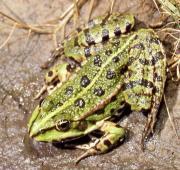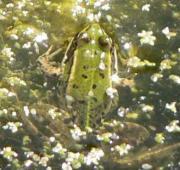 The marsh frog is a medium, fairly colourful species of frog that natively found in Europe. The marsh frog is closely related to the edible frog and the pool frog, all three of which belong to the family of "green frogs" (the common frog belongs to the brown frog family).
The marsh frog is a medium, fairly colourful species of frog that natively found in Europe. The marsh frog is closely related to the edible frog and the pool frog, all three of which belong to the family of "green frogs" (the common frog belongs to the brown frog family). The marsh frog is the largest species of true frog native to Europe and is found in deep ponds, lakes, rivers and around streams across the continent. The range of the marsh frog is wider than it once was, as the marsh frog is also found in parts of western Asia and Russia and even in some areas in China and Pakistan.
The marsh frog is the largest species of true frog native to Europe and is found in deep ponds, lakes, rivers and around streams across the continent. The range of the marsh frog is wider than it once was, as the marsh frog is also found in parts of western Asia and Russia and even in some areas in China and Pakistan.


As with many other amphibious animals, the marsh frog is a carnivore meaning that it only eats other animals in order to survive. Marsh frogs primarily feeds on small invertebrates in, on or close to water including various species of insect, spiders and moths.
The relatively small size of the marsh frog and easily spotted green skin, means that the marsh frog has a number of predators within it's natural environment. Birds, large toads, fish, mammals and lizards all prey on the marsh frog.
Marsh frogs tend to breed in the early spring, when mating takes place in calm, shallow pools of water. The female marsh frog lays around 1,000 eggs in a sticky cluster that floats on the water's surface, known as frogspawn. Once developed the marsh frog tadpoles emerge into the water where they are fully aquatic until they metamorphose into adult marsh frogs and are able to leave the water.
Today, although not in immediate danger of becoming extinct in the wild, the marsh frog populations are under increased threat due, primarily due to deforestation and pollution of their natural habitats.

